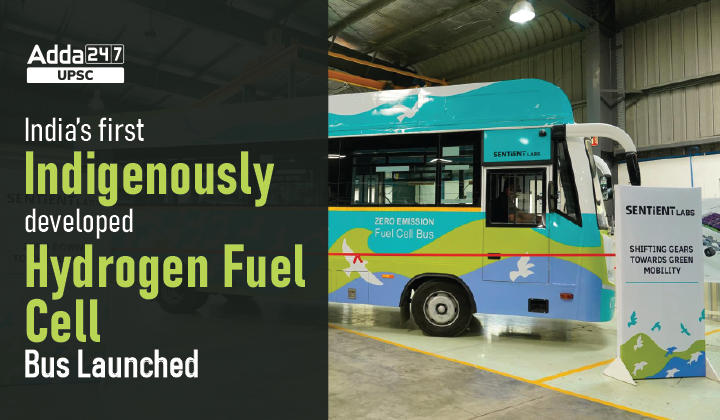Table of Contents
Hydrogen Fuel Cell Bus- Relevance for UPSC Exam
- GS Paper 2: Governance, Administration and Challenges- Government policies and interventions for development in various sectors and issues arising out of their design and implementation.
- GS Paper 3: Environment- Conservation, environmental pollution and degradation.
Hydrogen Fuel Cell Bus
- Recently, Union Minister Dr Jitendra Singh unveiled India’s first truly indigenously developed Hydrogen Fuel Cell Bus developed by KPIT-CSIR in Pune.
- India’s first truly indigenously developed Hydrogen Fuel Cell Bus is in tune with PM Modi’s National Green Hydrogen Mission.
Associated Benefits of Hydrogen Fuel Cell Bus
- Environmentally Sustainable: Fuel cell utilizes Hydrogen and Air to generate electricity to power the bus and the only effluent from the bus is water, therefore making it possibly the most environmentally friendly mode of transportation.
- For comparison, a single diesel bus plying on long distance routes typically emits 100 tons of CO2 annually and there are over a million such buses in India.
- Cheaper Mode of Travel: High efficiency of fuel cell vehicles and the high energy density of hydrogen ensures that the operational costs in rupees per kilometre for fuel cell trucks and buses are lower than diesel powered vehicles.
- Low cost of running the Hydrogen Fuel Cell Bus can bring freight revolution in India.
- Zero Green House Emission: Hydrogen Fuel Cell Bus vehicles also give zero green-house gas emissions.
- Hydrogen fuelled vehicles provide an excellent means to eliminate the on-road emissions from this sector.
- About 12-14% CO2 emissions and particulate emissions come from diesel powered heavy commercial vehicles and these are decentralised emissions and hence difficult to capture.
- Reducing Fossil Fuel Import: By achieving the Hydrogen Fuel led Transport Systm, India can pole-vault from being net importer of fossil energy to becoming net exporter of clean hydrogen energy.
- Global Leader in Hydrogen Fuel: Effective Implementation may lead to global leadership to India in hydrogen space by becoming a large green hydrogen producer and supplier of equipment for green hydrogen.
What is Green hydrogen?
- Green hydrogen is produced through electrolysis using renewable sources of energy such as solar, wind or hydel power.
- The ‘green’ depends on how the electricity is generated to obtain the hydrogen, which does not emit greenhouse gas when burned.
How Green hydrogen is different from Grey Hydrogen and Blue Hydrogen?
- Green hydrogen is produced through electrolysis using renewable sources of energy such as solar, wind or hydel power.
- Grey hydrogen is generated through fossil fuels such as coal and gas and currently accounts for 95% of the total production in South Asia.
- Blue hydrogen, too, is produced using electricity generated by burning fossil fuels but with technologies to prevent the carbon released in the process from entering the atmosphere.
National Hydrogen Mission- Key Points
- Background: The proposal for National Hydrogen Mission was made in the Budget 2021 to enable the generation of hydrogen “from green power sources”.
- About: On India’s 75th Independence Day, the Prime Minister of India announced the launch of the National Hydrogen Mission (NHM).
- Aim: National Hydrogen Mission aims to make India a global hub for the production and export of green hydrogen.
- Goal: National Hydrogen Mission is expected to help in meeting the target of production of 5 million tonnes of Green Hydrogen by 2030 and the related development of renewable energy capacity.
Green Hydrogen Policy | Green Ammonia Policy




 TSPSC Group 1 Question Paper 2024, Downl...
TSPSC Group 1 Question Paper 2024, Downl...
 TSPSC Group 1 Answer key 2024 Out, Downl...
TSPSC Group 1 Answer key 2024 Out, Downl...
 UPSC Prelims 2024 Question Paper, Downlo...
UPSC Prelims 2024 Question Paper, Downlo...
